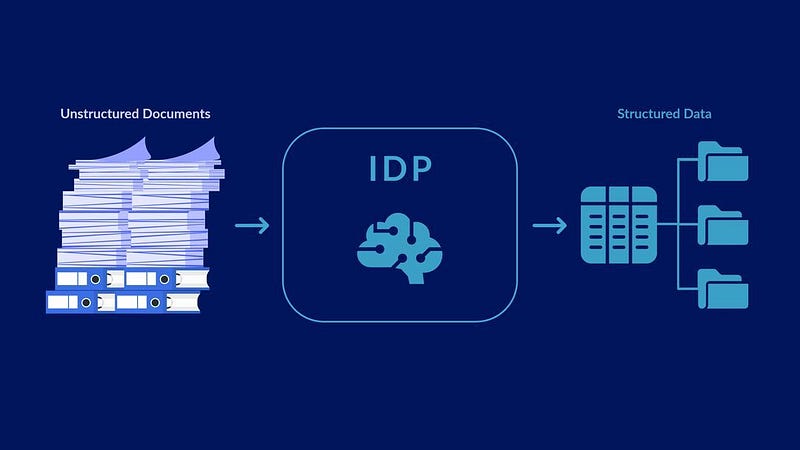What is so intelligent about Intelligent Document Processing?

Overview:
Intelligent Document Processing (IDP) refers to the automated process of analyzing, extracting, and categorizing data from various types of documents. It is a digital transformation technology that revolutionizes the way organizations manage their information. IDP has become an essential tool for businesses of all sizes, providing them with increased efficiency, accuracy, and speed in managing their documents.

When and why did it start?
The concept of IDP started to gain traction in the late 1990s when the need for digitization of paper-based documents became more pressing. With the rise of digital technologies, organizations began to see the need for automated and efficient document processing to manage the increasing volume of data generated by their operations.
How was it before and how is it happening now?
Before the advent of IDP, document processing was a time-consuming and manual process that involved manual data entry and manual categorization of documents. This was a slow and error-prone process that often resulted in data inconsistencies and reduced productivity.
Today, IDP has come a long way. With advancements in artificial intelligence (AI) and machine learning (ML), IDP has become a highly automated and sophisticated technology that can process large volumes of data with increased accuracy and speed.
What problems does it solve?
IDP solves a range of problems faced by organizations in managing their documents, including:
- Inefficient manual data entry and categorization
- Inconsistent data quality due to manual errors
- Time-consuming document processing
- Increased risk of data loss and security breaches
- Inability to access important information quickly and easily
Business Architecture
The business architecture of IDP is designed to provide organizations with a centralized repository for their documents, where they can access and manage their information easily and efficiently. IDP solutions typically include features such as document scanning, optical character recognition (OCR), data extraction, and categorization, as well as data analytics and reporting.

Popular Process
The process involved in IDP typically includes the following steps:
- Document scanning and image recognition
- Optical character recognition (OCR)
- Data extraction
- Categorization of data
- Data validation and correction
- Data storage and management
Benefits
IDP provides organizations with a range of benefits, including:
- Increased efficiency and productivity
- Improved data quality and accuracy
- Quick and easy access to important information
- Reduced risk of data loss and security breaches
- Improved compliance with regulatory requirements
- Increased visibility into organizational data and processes
Results
IDP has been a game-changer for organizations of all sizes, providing them with increased efficiency, accuracy, and speed in managing their documents. According to recent studies, IDP solutions can reduce manual data entry time by up to 80%, and improve data accuracy by up to 99%. These results demonstrate the significant impact that IDP can have on an organization’s bottom line.
Role of AI and ML
AI and machine learning (ML) play a critical role in the development of IDP technology. These technologies enable IDP systems to process and analyze large volumes of data, extract relevant information, and categorize documents based on predefined criteria. AI and ML also provide IDP systems with the ability to learn and improve over time, ensuring that they can keep up with the changing needs of organizations.
Top Companies for IDP
There are many companies that offer IDP solutions, including:
- DocuContext by Dlytica
Learn more about DocuContext here : https://www.dlytica.com/product/docucontext/
- AWS Textract
- Adobe
- IBM
- Microsoft
- OpenText
- Oracle
- SAP
Conclusion
Intelligent Document Processing has come a long way since its inception, and today it is an essential tool for businesses of all sizes. With the increasing demand for digital transformation, IDP is poised to become an even more critical technology in the years to come. Whether you’re looking to streamline your document management processes, improve data quality and accuracy, or gain greater visibility into your organizational data and processes, IDP is an investment worth considering.
What’s next?
Want to learn more.
We have number of solutions to help you to modernize your Data Warehouse.
1. Free Data Architecture Consultation
2. Pay as you go data resources
3. Robotic Process Automation
4. Data Warehouse Solution
5. Big Data and BI
Recent Post
What Is a Sovereign AI Lakehouse Platform? A sovereign AI lakehouse platform unifies data lake and data warehouse capabilities with built‑in AI t [...]
Why Enterprises Are Choosing DataNature over Cloudera, Databricks, and Snowflake? Across Canada, banks, telcos, and public-sector organizations a [...]
Empowering businesses with unified data, intelligent automation, and real-time insights. Introduction: How an AI Data Platform Drives Enterprise [...]
Introduction Artificial Intelligence (AI) is quickly changing industries, and this is most obvious in the finance and banking worlds. From fraud [...]
Introduction In today’s digital environment, data-driven technologies are reshaping how companies operate. Every day, organizations produce enorm [...]
Introduction Customer data is growing at lightning speed, but making sense of it remains a challenge. This is where AI agents in customer analyti [...]
Introduction Big Data and AI are transforming the way businesses handle massive datasets. In today’s fast-paced digital world, organizations stru [...]
Introduction The Banking and Financial Services (BFSI) industry is at the edge of a major transformation. With rising customer expectations, incr [...]
Introduction In the rapidly evolving world of technology, the development of customized Large Language Models (LLMs) is a frontier being explored [...]
Introduction: In the rapidly evolving technology landscape, Data and Artificial Intelligence (AI) are reshaping industries and revolutionizing bu [...]
Introduction: Language is the glue that connects us in this digital age. From chatbots that converse with us to virtual assistants that understan [...]
In the modern business landscape, data is the new oil, powering decisions and strategies across sectors. Dlytica Inc., with its cutting-edge data [...]
Data Analyst: A Data Analyst scrutinizes numeric data to aid companies in making informed decisions. They are often the entry point for individua [...]
Introduction Collision 2023, the largest AI event of the year, served as a vibrant hub of innovation, collaboration, and knowledge-sharing. In th [...]
Overview Intelligent Document Processing (IDP) is an Artificial Intelligence (AI)-driven technology that is rapidly transforming the way business [...]
Overview In today’s fast-paced business world, companies generate a vast amount of data, most of which is stored in paper-based or unstructured d [...]
Overview The insurance industry generates a vast amount of unstructured, semi-structured and structured documents in the form of policies, claims [...]
Overview Intelligent Document Processing (IDP) refers to the use of Artificial Intelligence (AI) technologies to automate the data extraction pro [...]
In the digital age, businesses are constantly looking for ways to streamline their operations and increase efficiency. One area that holds great [...]
Overview: Intelligent Document Processing (IDP) refers to the automated process of analyzing, extracting, and categorizing data from various type [...]
Introduction: Cloud computing is a technology that allows users to store, access, and manage data and applications over the internet. Instead of [...]
Introduction to Resource Augmentation IT resource augmentation services are a growing trend in the business world, as organizations look for ways [...]
Introduction to Data Warehouse A data warehouse is a centralized repository of structured and organized data that is used for reporting, analysis [...]
Overview: Robotic process automation (RPA) is a software technology that makes it easy to build, deploy, and manage software robots that emulate [...]
How can AI automate Insurance Industry? In this article, you will learn : What is Insurance Claim Process Automation? Claims Processing is t [...]
What is CMAP? One of the premium solution provided by Dlytica is Cloud Migration Acceleration program (CMAP).Migrate to cloud with our suppo [...]
With an Innovative team at DLytica, we work on converting your Data Strategies to Solutions. We leverage a team of skilled Data Architects, Data [...]
Who are we? Company’s tagline : Drive your business with Data Analytics and AI with DLytica Inc. With an Innovative team at DLytica, we [...]
Overview: Fraud is evolving and nowadays it looks more like organized crime with international and cross-functional teams involved. It means that [...]
